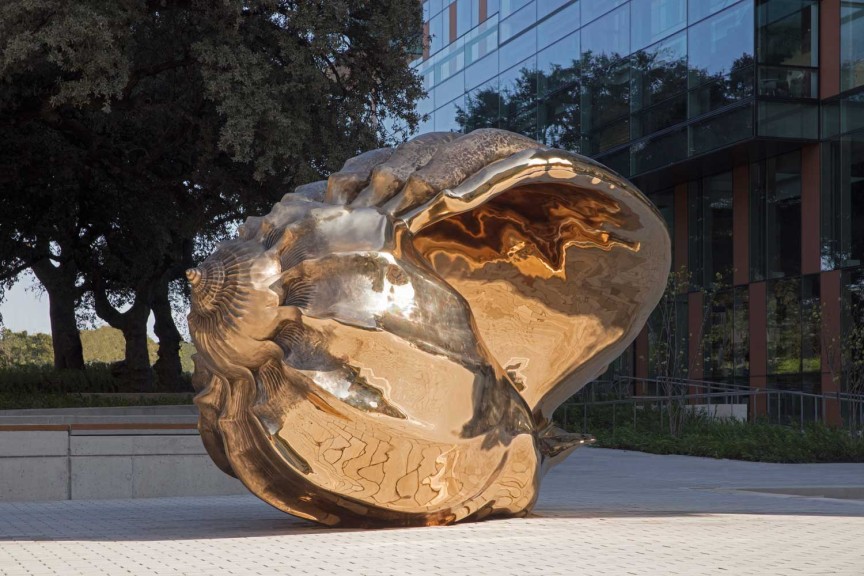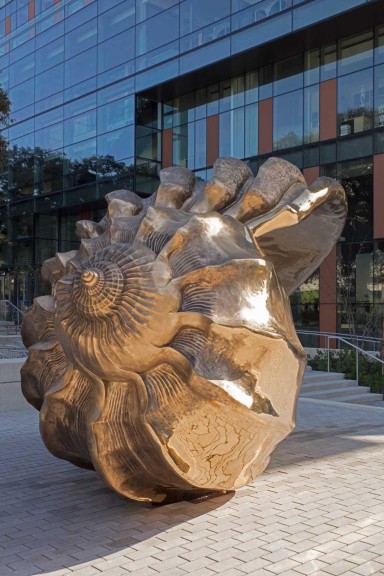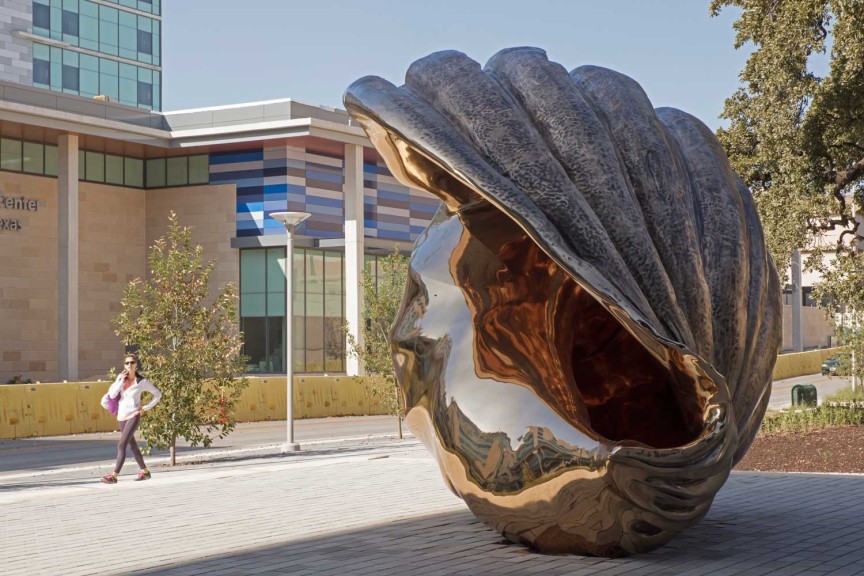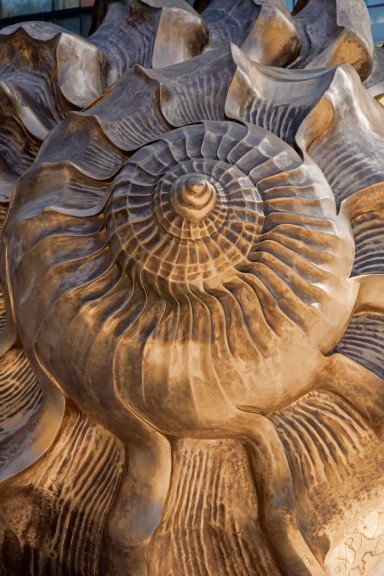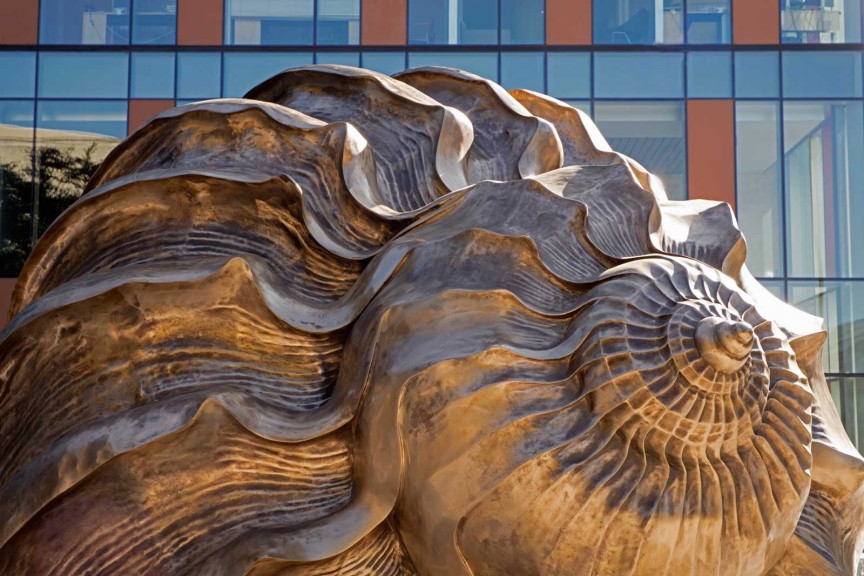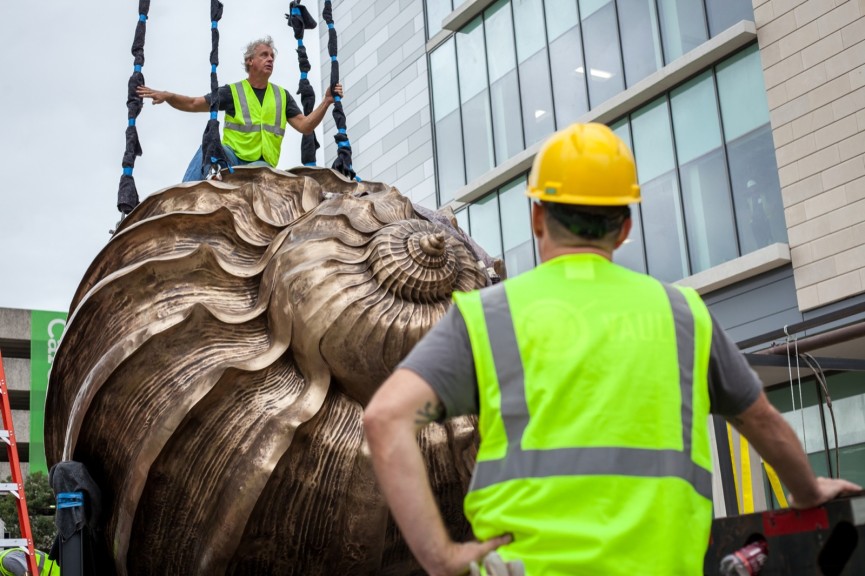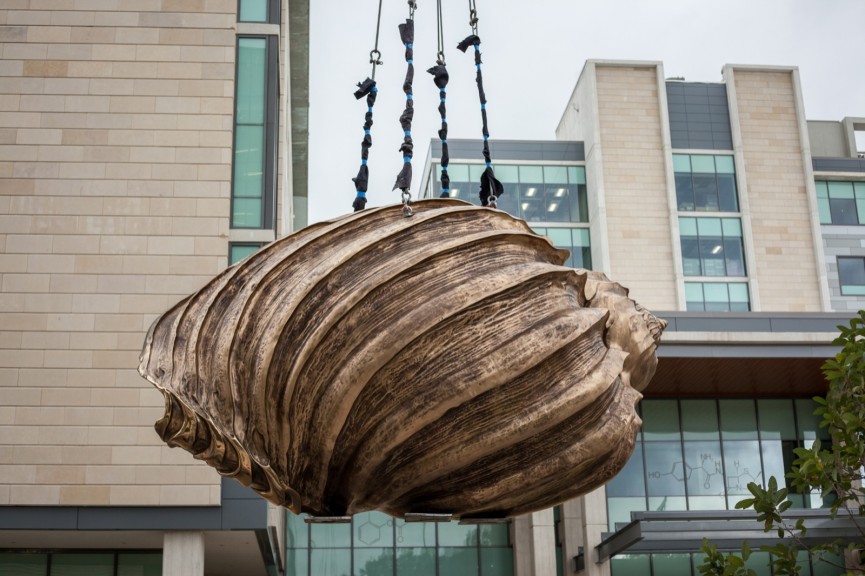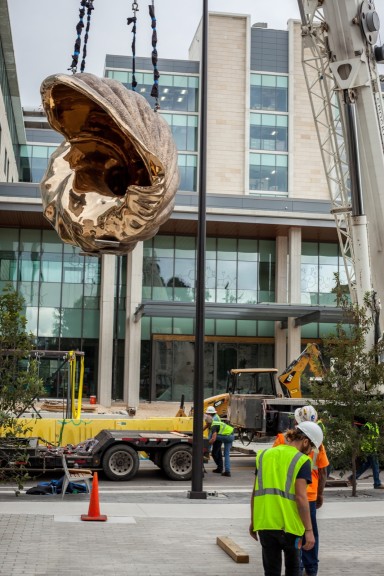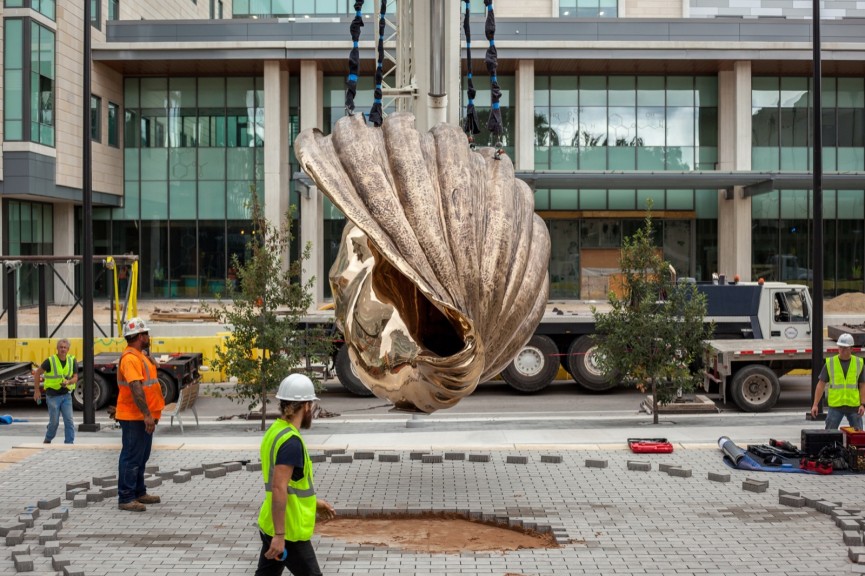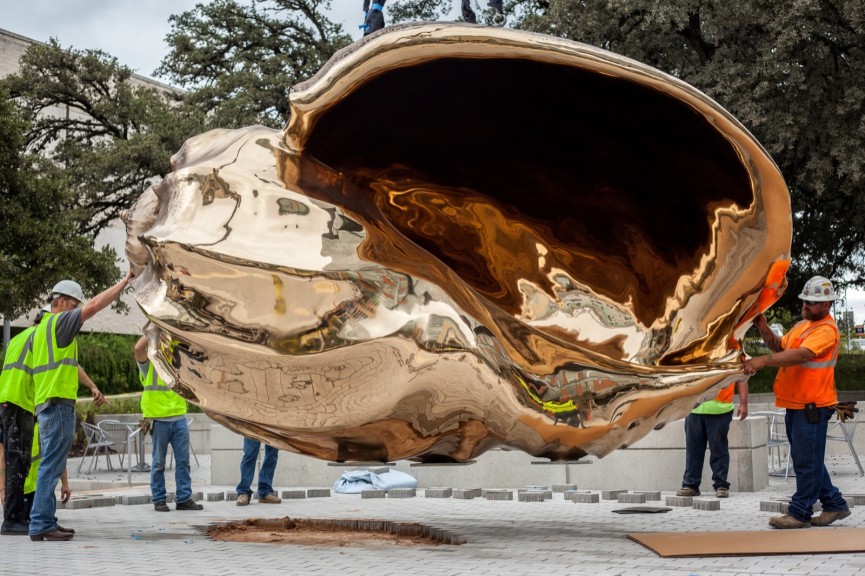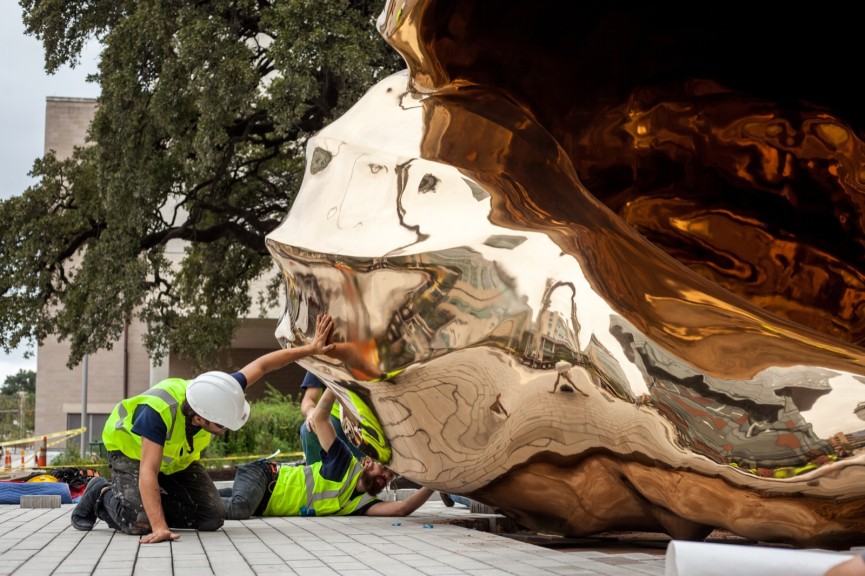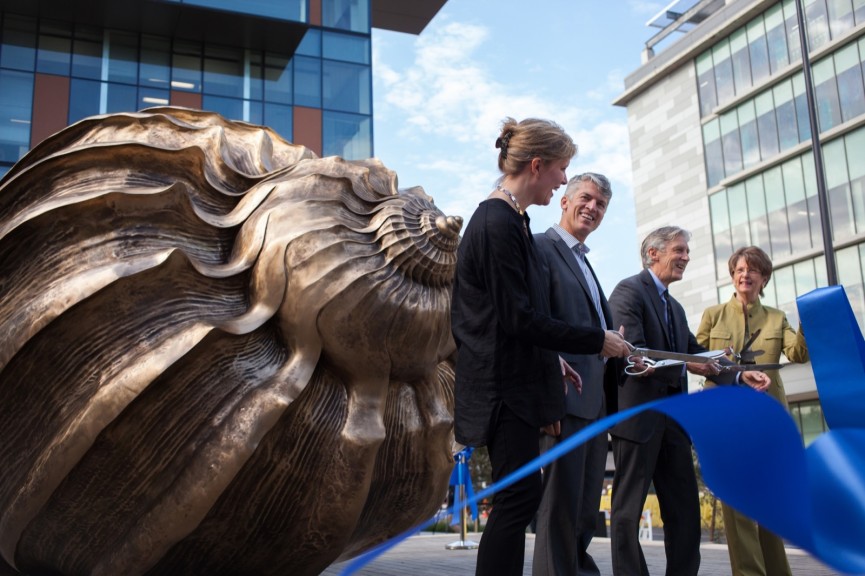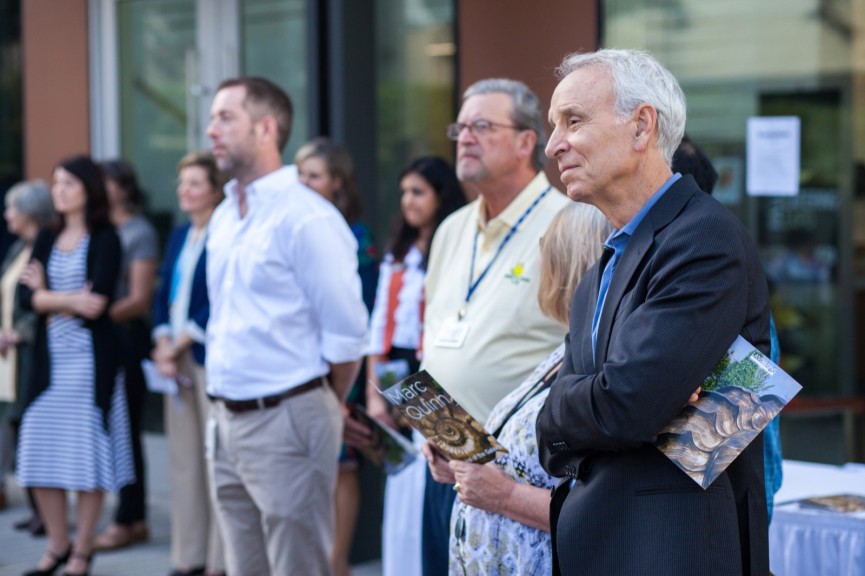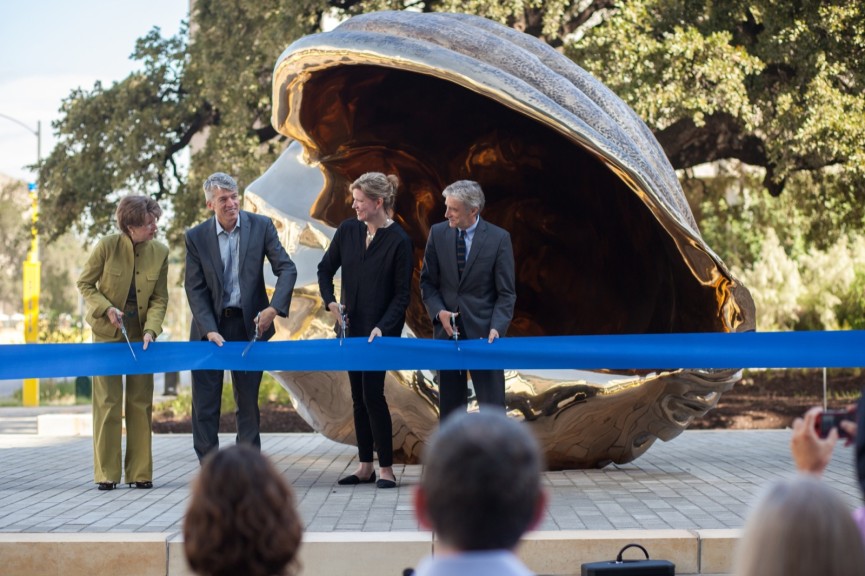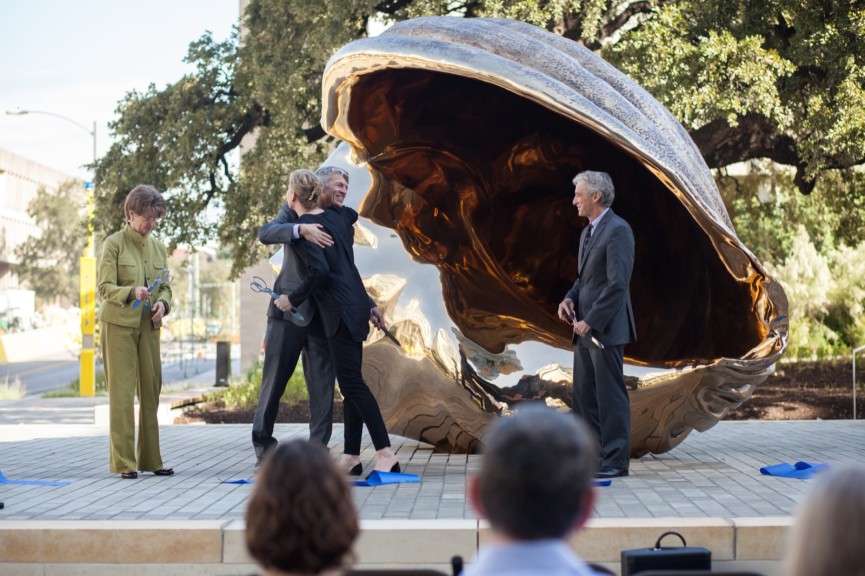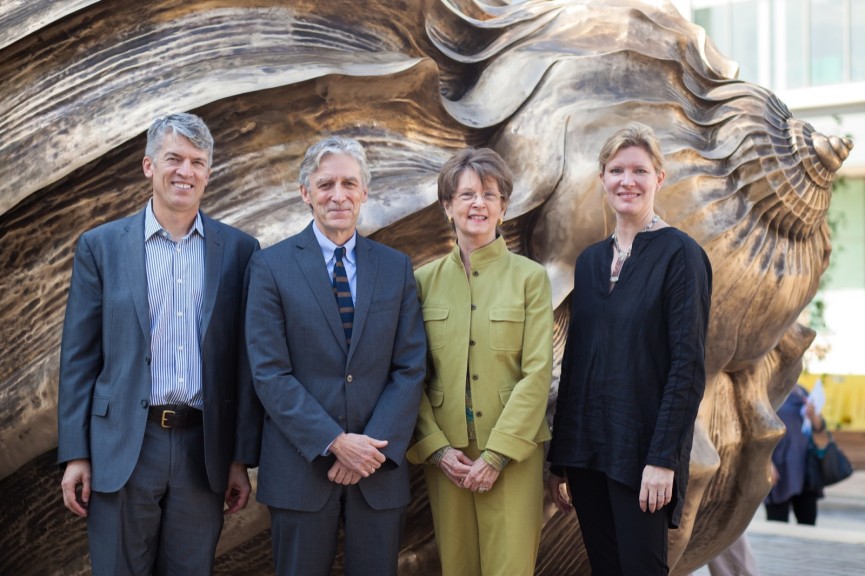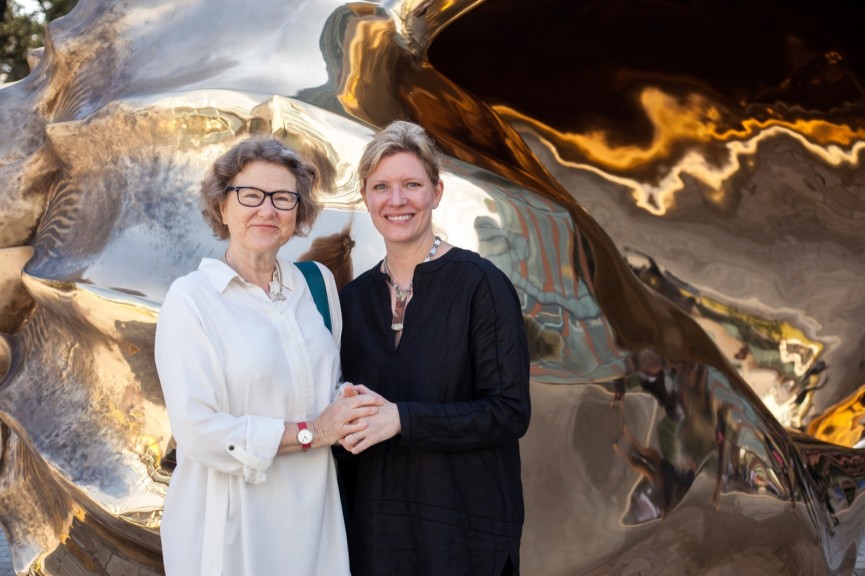In his sculptural series, The Archaeology of Art, Marc Quinn creates monumental forms by digitally scanning and casting seashells housed in the British Natural History Museum. By dramatically altering the shell’s material, scale, and surroundings, Spiral of the Galaxy acquires a mythical aspect, quivering between the real and the fantastical. Quinn has called seashells “the most perfect pre-existing sculptural ‘readymades’ in our natural world,” referring to the graceful intricacy of their forms and the wonder of their natural production.
More information
Landmarks purchased Spiral of the Galaxy by Marc Quinn to anchor the gateway to the Dell Medical School. The conch carries cultural and religious significance, and among many interpretations can be seen here as a complex structure that protects delicate organisms.
Funding for the acquisition of Spiral of the Galaxy was provided by the capital improvement project for Dell Medical School. This project would not have been possible without generous assistance from many including:
Leadership
Andrée Bober and Landmarks
Pat Clubb and University Operations
Douglas Dempster and the College of Fine Arts
Gregory Fenves and the Office of the President
Clay Johnston and Dell Medical School
Landmarks Advisory Committee
Bob Rawski and the Office of Facilities Planning and Construction
David Rea and the Office of Campus Planning and Facilities Management
Frederick Steiner and the Campus Master Planning Committee
Project Team
Nisa Barger, project manager, Landmarks
Andrée Bober, curator and director, Landmarks
Karel Kozeh, Office of Facilities Planning and Construction
Hansel Phelps
Marc Quinn, artist
Page Sutherland Page
Sasaki and Associates
Patrick Sheehy and Vault Fine Art Services
Special Thanks
Mary Boone, Mary Boone Gallery
Deb Duval, event coordinator
Gilles Heno-Coe, collections management, Landmarks
Masterpiece International
Nick Nobel, external affairs, Landmarks
Jim Oliver, Mary Boone Gallery
Bill Simpson, Office of Facilities Planning and Construction
Damian Smith, Marc Quinn studio
Larry Speck, School of Architecture
Stephanie Taparauskas, development, Landmarks
Amanda Tofflemire, Dell Medical School
Jennalie Lyons, development, Landmarks
Ron Warren, Mary Boone Gallery
Robin K. Williams, curatorial contributor
Misa Yamamoto, College of Fine Arts
Catherine Zinser, education, Landmarks
Seven-ton ‘Spiral of the Galaxy’ sculpture unveiled at UT med school
Jeanne Claire van Ryzin, Austin360, 10 November 2016
Marc Quinn's enormous bronze sculpture "Spiral of the Galaxy" was officially unveiled today at UT's Dell Medical School.
Stunning sculpture makes landmark move to University of Texas campus
Nicole Raney, CultureMap, 25 October 2016
The stunning work from a world-renowned artist has a new home at the University of Texas. On Monday, Spiral of the Galaxy by Marc Quinn was formally unveiled at 15th and Red River streets, the gateway to the new Dell Medical School campus.
Landmarks unveils large-scale outdoor sculpture Spiral of the Galaxy at Dell Medical School
Marc Quinn’s stunning work enters its permanent home at the Health Learning Building
AUSTIN, Texas — 24 October 2016 — Landmarks, the public art program of The University of Texas at Austin, hosted a public ceremony in which Spiral of the Galaxy, a tremendous seven-ton bronze sculpture by British artist Marc Quinn, was unveiled.
The public gathering was led by Landmarks director Andrée Bober and included remarks by Clay Johnston, dean of Dell Medical School, Doug Dempster, dean of College of Fine Arts, and Pat Clubb, vice president for University Operations. They spoke in front of the elegant conch shell which stands nearly 11 feet tall and more than 16 feet wide on the northeast corner of 15th and Red River Streets.
“Every installation Landmarks does is an educational provocation,” said Dean Doug Dempster. “[Marc Quinn] is an artist who is intrigued by the relationship between the beautiful, the grotesque and the mundane. He’s always looking at the relationship between art and science.”
Located next to the new Dell Medical School’s Health Learning Building, and at the heart of the burgeoning health district in downtown Austin, Marc Quinn’s sculpture is emblematic of the human form and healing. The seven-ton bronze depicts an elegant conch shell with chambers that gradually expand in an outward direction. The conch carries cultural and religious significance, and among many interpretations can be seen here as a complex structure that protects delicate organisms.
Modeled after a specimen in the British Natural History Museum, the shell was cast as Quinn’s proof alongside an edition of three and it is the only example of the sculpture in the United States. It was first shown at an exhibition of the artist’s work in 2013 at the Giorgio Cini Foundation in Venice, Italy.
The capital improvement project for the Dell Medical School provided funding to acquire the sculpture. The University of Texas at Austin’s Art in Public Spaces policy sets aside one to two percent of new construction and major renovation funds to acquire public art. Landmarks, one of the most important public art programs to emerge at an American university, added the work to its growing collection of public art presented throughout Austin’s 433-acre main campus. Other artists represented include Michael Ray Charles, Mark di Suvero, David Ellis, Sol LeWitt, Ben Rubin, Nancy Rubins and James Turrell. The collection is broadly accessible and free to all, providing opportunities for students and visitors to engage with great works of art.
Marc Quinn has used his art to investigate the intersection of art and science through a variety of different mediums since catapulting into prominence in the early 1990s. Throughout his career, Quinn has also explored the idea of the human body in relation to perceptions of beauty through such critically acclaimed projects as Self (1991), a cast of the artist’s head made from ten pints of his own frozen blood, and Alison Lapper Pregnant (2005), a marble sculpture depicting disabled artist Alison Lapper, among others. Using both traditional and non-traditional materials, Quinn’s work focuses on the materiality of the object; touching such issues as genetics and the manipulation of DNA, as well as those of life, death and identity.
Born in London in 1964, Quinn studied history and the history of art at Cambridge University. Following his graduation, Quinn worked as an assistant to the sculptor Barry Flanagan. He has exhibited internationally in museums and galleries including Tate Gallery, London (1995), Kunstverein Hannover (1999), Fondazione Prada, Milan (2000), Tate Liverpool (2002), MACRO, Rome (2006), Fondation Beyeler, Basel (2009), White Cube, London (2010), Musée Océanographique, Monaco (2012), and Arter, Space for Art, Istanbul (2014). A major exhibition by Quinn took place at White Cube, London in the summer of 2015.
Spiral of the Galaxy comes to The University of Texas at Austin through the tireless contributions of Landmarks, College of Fine Arts, Office of the Vice President for University Operations, Dell Medical School and Vault Fine Arts Services.
Landmarks, the public art program of The University of Texas at Austin, acquires major works by Marc Quinn and Ann Hamilton
Landmarks' collection expands with the acquisition of a monumental sculpture by Marc Quinn and a newly commissioned project by Ann Hamilton
Austin, Texas – 7 July 2016 – Landmarks today announced two significant additions: the recent acquisition of Marc Quinn’s 2013 sculpture, Spiral of the Galaxy, to be unveiled on 24 October 2016; and the commission of O N E E V E R Y O N E, a community-based photography project by Ann Hamilton (January 2017). Both works will be installed at the university’s Dell Medical School and are funded through a percent-for-art allocation that sets aside one-to-two percent of capital improvement projects for the acquisition of public art.
“Adding Marc Quinn and Ann Hamilton to the diverse roster of artists represented by Landmarks is an honor,” said Andrée Bober, the founding director of the program. “Quinn’s biomorphic sculpture and Hamilton’s intimate portraits complement each other in unexpected ways. Both wrestle with bigger ideas about the human form and healing, making them ideally suited for the new Dell Medical School.”
Marc Quinn’s artistic practice is preoccupied with the mutability of the body and the dualisms that define human life: spiritual and physical, surface and depth, cerebral and sexual. Spiral of the Galaxy, Quinn’s seven-ton bronze sculpture, was first shown at an exhibition of the artist’s work in 2013 at the Giorgio Cini Foundation in Venice, Italy. Landmarks’ acquisition was cast as the artist’s proof alongside an edition of three, and it will be the only example of the piece in the United States. Placed at the gateway to the Dell Medical School, the monumental sculpture depicts an elegant conch shell. The conch carries cultural and religious significance, and among many interpretations can be construed here as a complex structure that protects delicate organisms.
Ann Hamilton engaged in a three-part residency for Landmarks to create portraits of local community members. Her images evoke the human form, touch, and the care and attention of healers. During each residency, she photographed volunteers through a semi-transparent membrane that renders in focus only what touches the surface and softly blurs the gestures and outlines of the sitters. The optical quality of the material renders touch—something felt more than seen—visible. The life of every citizen will intersect with the health care system and these portraits include caregivers, faculty, students, staff, community partners, civic leaders and patients themselves.
Hamilton will select around two dozen portraits to install in the new Center for Health Learning and Center for Health Discovery buildings in early 2017. Her library of approximately 500 subjects may be used in future buildings of the Dell Medical School as well as in other graphic applications, including a book that contains images of each participant. 10,000 copies will be given to the public, and portraits will be available to download online for free. With more than 500 portraits taken in various locations across the city, Hamilton’s residency in Austin is the largest O N E E V E R Y O N E series developed to date.
“The University of Texas at Austin is building the first new medical school at a top-tier research university in nearly 50 years, offering the unique opportunity to rethink the role of academic medicine in better serving society’s needs,” said Clay Johnston, inaugural dean of the Dell Medical School. “With unprecedented support from our community, we are creating a medical school for the 21st century that draws upon innovative thinking from across disciplines, from engineering to the arts. Public art that starts conversations and inspires creativity and community connections is vital to the environment we envision.”
The installation of these two works supports Landmarks’ broader strategy to develop an extraordinary public art collection that both enhances the aesthetic character of the campus and supports pedagogy. An ongoing percent-for-art allocation ensures the collection will develop in tandem with the rapid expansion of the campus. With these upcoming additions, Landmarks continues to advance its mission to present iconic works of art that convey the university’s ideals.
In addition to site-specific commissions and acquisitions, Landmarks features 28 mid- to late-20th-century sculptures on long-term loan from the Metropolitan Museum of Art, including works by Magdalena Abakanowicz, Louise Bourgeois, Deborah Butterfield, Anthony Caro, Jim Dine, Donald Lipski, Beverly Pepper, Antoine Pevsner, Tony Smith, and Ursula von Rydingsvard. Beyond its aesthetic value, the group demonstrates significant art historical trends from the second half of the 20th century. The collection also fosters learning through its conservation efforts. Landmarks provides technical training for student volunteers who preserve the sculptures, the only known program of its kind in the United States.
Marc Quinn was born in London in 1964. He graduated from Cambridge University with a degree in history and history of art, and subsequently worked as an assistant to the sculptor Barry Flanagan. He is one of the leading artists of his generation, creating sculptures, paintings, and drawings that explore the dynamic between art and science, and the human body relative to perceptions of beauty. Other key subjects include cycles of growth and evolution through topics such as genetics and the manipulation of DNA, as well as issues of life, death, and identity. Quinn’s work uses a broad range of materials, both traditional and unorthodox. The materiality of the object, in both its elemental composition and surface appearance, is at the heart of Quinn’s work.
Ann Hamilton was born in Lima, Ohio, in 1956. She received a BFA in textile design from the University of Kansas in 1979 and an MFA in sculpture from the Yale School of Art in 1985. Ann Hamilton is a visual artist internationally recognized for the sensory surrounds of her large-scale multimedia installations. Using time as process and material, her methods serve as an invocation of place, of collective voice, of communities past and of labor present. Her ephemeral environments create immersive experiences that poetically respond to the architectural presence and social history of their sites.
Discover more about Marc Quinn and Spiral of the Galaxy by visiting the collection page.
Contact
Landmarks
The University of Texas at Austin
College of Fine Arts
2616 Wichita St., A7100
BWY 3rd Floor
Austin, TX 78712
info@landmarksut.org
512.495.4315
Press Office
An Phung
Digital Content Coordinator
Landmarks
an.phung@landmarksut.org
512.232.5904

